Publications
Canadian Survey on Disability, 2012:
Mental health-related disabilities among Canadians aged 15 years and older, 2012
Mental health-related disabilities among Canadians aged 15 years and older, 2012
Archived Content
Information identified as archived is provided for reference, research or recordkeeping purposes. It is not subject to the Government of Canada Web Standards and has not been altered or updated since it was archived. Please "contact us" to request a format other than those available.
Correction notice
Correction date: July 20, 2015
Corrections have been made to this product.
Please take note of the following changes:
As a result of data rounding errors, the following corrections have been made:
- Counts for dexterity, seeing and developmental disabilities and percentage for seeing in table 1;
- Percentages in 'Multiple disabilities', 'Not in labour force' and 'Educational attainment' sections;
- Percentages in footnotes 2 and 5;
- Percentages for '15 to 24 years' and '55 to 64 years' with a disability in chart 4 and all percentages in chart 6;
- Employment income in 'Personal income for working-age adults' section.
Median income values in the 'Personal income for working-age adults' were also corrected to include negative and zero values for persons with disabilities.
We regret any inconvenience this may have caused.
The results presented in this fact sheet are from the 2012 Canadian Survey on Disability (CSD), which surveyed residents of private dwellings who reported an activity limitation and who were aged 15 years and older at the time of the 2011 National Household Survey (NHS).
According to the CSD, respondents are considered to have a disability not only if they report a difficulty or impairment due to a long-term condition or health problem, but also if they report that they are limited in their daily activities as a result of their condition. Appendix A describes how the CSD defines mental health-related disabilities.
It should be noted that the population living in institutions, including residential care facilities, was not included in the 2012 CSD. Further details are available in the Canadian Survey on Disability, 2012: Concepts and Methods Guide. 89-654-X2014001
According to the 2012 Canadian Survey on Disability (CSD), some type of disability was reported by 3,775,900 (13.7%) Canadians aged 15 years and older, among whom 1,059,600 (3.9%) reported having a mental health-related disability (Table 1).Note 1 The most prevalent underlying mental health conditions reported were anxiety, depression, and bipolar disorder. Other underlying mental health conditions reported on the survey included schizophrenia, substance abuse, and anorexia.
| Disability type | Population | Percentage |
|---|---|---|
| Total disability | 3,775,900 | 13.7 |
| Pain-related | 2,664,200 | 9.7 |
| Flexibility | 2,078,000 | 7.6 |
| Mobility | 1,971,800 | 7.2 |
| Mental health-related | 1,059,600 | 3.9 |
| Dexterity | 953,100 | 3.5 |
| Hearing | 874,600 | 3.2 |
| Seeing | 756,300 | 2.8 |
| Memory | 628,200 | 2.3 |
| Learning | 622,300 | 2.3 |
| Developmental | 160,500 | 0.6 |
| Unknown | 79,500 | 0.3 |
|
Note: Individuals may have more than one type of disability; therefore, the sum of all individual disability types is greater than the number of “total disabilities". Source: Statistics Canada, Canadian Survey on Disability, 2012. |
||
As highlighted in Chart 1, mental health-related disability as a proportion of all disability declined as age increased. Mental health-related disability was the most prevalent disability type reported by young adults aged 15 to 24, and this was followed closely by learning disabilities in terms of prevalence for this age group. Among young adults, 4.4% reported some type of disability, and half of them (2.2%) reported a mental health-related disability.
The prevalence of mental health-related disabilities was higher for women than men among those aged 25 to 44 (3.2% and 2.3% respectively) and among those aged 45 to 64 (5.9% and 4.7%), but not among those aged 15 to 24 or among those aged 65 and older.
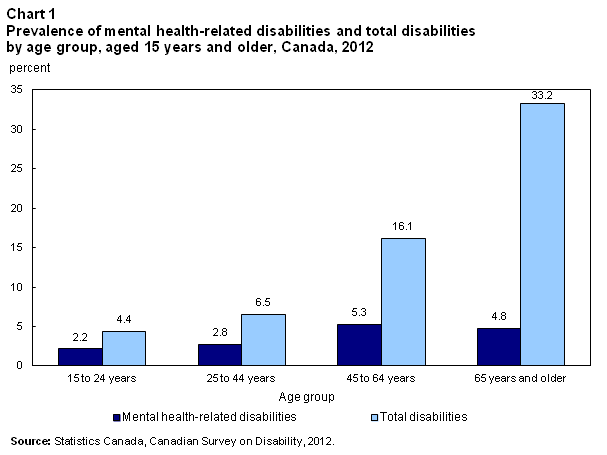
Multiple disabilities
Mental health-related disability frequently co-occurred with other types of disability: 91.7% of those with mental health-related disabilities also reported at least one other type of disability in 2012.
The pattern of co-occurrence varied by age. Adults aged 15 to 24 who reported mental health-related disabilities also reported learning and developmental disabilities more frequently than those in the older age groups. On the other hand, older adults aged 65 and older who reported mental health-related disabilities also reported memory, sensory and physical disabilities more frequently than did adults aged 15 to 24.
While both younger adults and seniors with mental health-related disabilities had high rates of co-occurrence with physical disability types, there were some interesting nuances. Among those aged 15 to 24 with mental health-related disabilities, over half (53.9%) also reported at least one of the physical disability types. However, this was mostly driven by having a pain-related disability (41.2% of those aged 15 to 24 with mental health-related disabilities had a pain-related disability). Among seniors aged 65 and older, with mental health-related disabilities, 90.1% also had a physical disability, which comprised almost an equal representation of pain-related disabilities (76.2%) as well as mobility (74.6%) and flexibility (71.1%) disabilities.
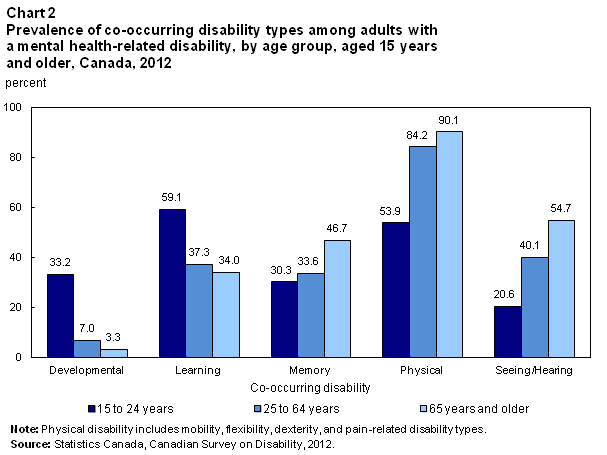
Education
Educational attainment
Adults with mental health-related disabilitiesNote 2 had overall lower levels of educational attainment than those who did not have any type of disability. For example, adults aged 15 to 64 who were not in school and who reported a mental health-related disability were more likely than those without any type of disability to have not completed high school (23.3% versus 13.1%); and this pattern was particularly pronounced among those aged 25 to 44 with mental health-related disabilities who were more than twice as likely to have not completed high school, compared with their counterparts without any type of disability (25.7% versus 9.5%).
Similarly, those aged 15 to 64 with a mental health-related disability were also less likely (46.3%) than their counterparts without a disability (61.1%) to have completed post-secondary qualifications.Note 3
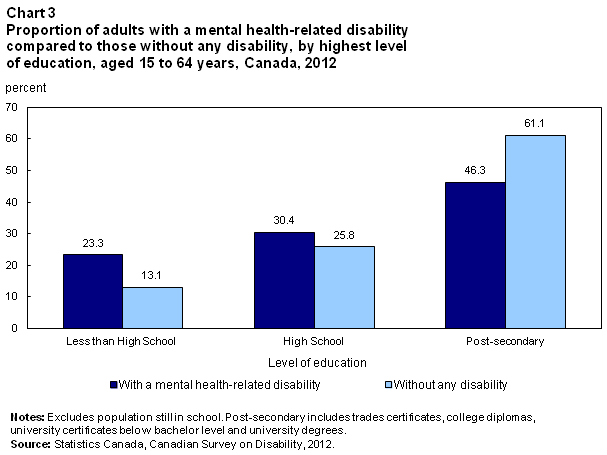
Effect of disability on educational experiences
In the 2012 CSD, adults with a disability who were currently or had recently been in school were asked a series of questions about their educational experiences and how their condition or conditions may have affected these experiences.Note 4 More than half of the adults with a mental health-related disability reported that their condition(s) had influenced their choice of courses/careers, resulted in them taking fewer courses and resulted in them taking longer to achieve their current level of education (Table 2).
| Effect of disability | Percentage |
|---|---|
| Choice of courses/career influenced by disability | 59.8 |
| Took fewer courses due to disability | 58.1 |
| Took longer to achieve current level due to disability | 58.0 |
| People avoided/excluded you in school due to disability | 48.8 |
| Education interrupted due to disability | 45.7 |
| Bullied at school because of disability | 43.0 |
| Discontinued education due to disability | 41.0 |
| Changed course of studies due to disability | 40.5 |
|
Note: Includes individuals currently in school or in school within the last five years and who had a disability while in school. Source: Statistics Canada, Canadian Survey on Disability, 2012. |
|
Employment
Labour force status
More than half (55.3%) of adults aged 15 to 64 with a mental health-related disability were not in the labour force, and another 8.8% were unemployed.Note 5
The employment rate of working-age adults, aged 15 to 64, with mental health-related disabilities was 35.9%, less than half the employment rate of those aged 15 to 64 who did not have any type of disability (73.6%). There were no statistically significant gender differences in employment rates between women and men with a mental health-related disability regardless of age.
In each age group, those without any disability were roughly twice as likely to be employed as those with a mental health-related disability. This pattern was more pronounced in the older age groups (Chart 4).
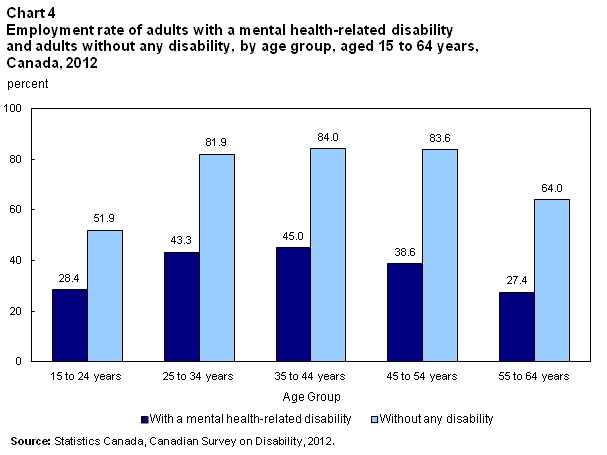
Disability in the workplace
Nearly a third (30.3%) of adults with a mental health-related disability and who were employed indicated that their employer was unaware of their condition(s).
Among those with a mental health-related disability and who were either currently in the labour market or had been within the previous five years, 63.7% reported that they felt disadvantaged in employment and 61.5% reported that they believed their employer considered them disadvantaged in employment (Chart 5). With respect to more specific indicators of disadvantage in the labour market, 19.4% believed that they had been refused a job, 14.8% felt they had been refused a promotion, and 12.5% believed they had been refused a job interview – all due to their disability or disabilities. It is important to remember that this is based upon the impact of all disability types these individuals with a mental health-related disability may have had.
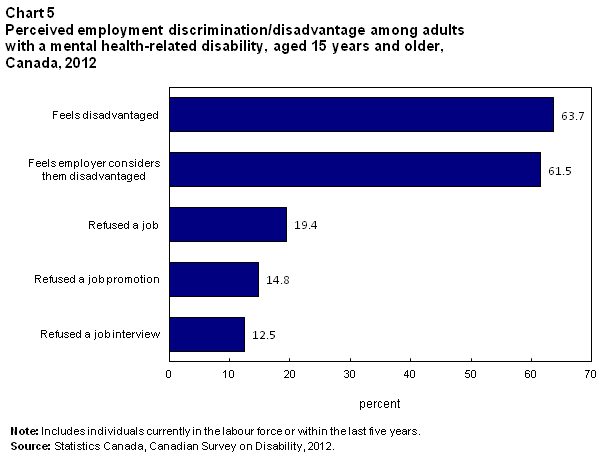
Job modifications
Overall, 52.0% of adults with a mental health-related disability who were or had been recently employedNote 6, stated that they needed at least one type of work accommodation such as modified work hours (35.1%), modified duties (20.3%), and other job accommodations. Of those requiring modifications, 44.1% reported that all of their needs had been met, while 27.3% indicated that some needs had been met. Another 28.6% reported that none of their needs had been met. Given the high rate of co-occurrence with other types of disabilities, some of these accommodations may have been for disabilities other than mental health-related.
Hours worked
Employed, working-age adults aged 15 to 64 with a mental health-related disability worked an average of 30 hours per weekNote 7, less than the average number of hours worked per week by those without any reported type of disability (37 hours).Note 8
Not in the labour force
Among those with a mental health-related disability aged 15 to 64 who were not in the labour force, 79.6% reported that their condition prevented them from working. Of these individuals, 19.3% indicated that some type of accommodation would allow them to work. As well as 27.8% indicated that they would look for work in the next 12 months.Note 9 Respondents who planned to look for work were asked why they intended to do so:
- 36.7% expected their condition to improve,
- 13.6% expected workplace changes/improvements, and
- 14.4% planned to take training.
Many of those who were not in the labour force encountered barriers that discouraged them from looking for work. Some of the most commonly reported job search barriers for those with a mental health-related disability were lack of available local jobs (26.5%) and inadequate training or experience (24.8%) (Chart 6).
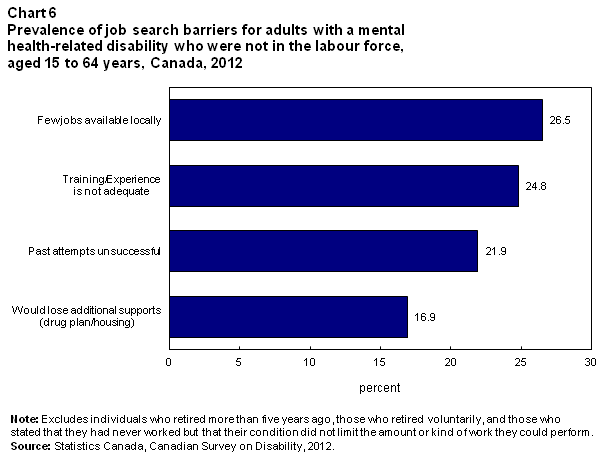
Income
Personal income for working-age adults
The median personal income (before taxes) of working-age adults aged 15 to 64 with a mental health-related disability Note 10 was $14,700—less than half that of those without any reported type of disability ($31,200).Note 11 Those with a mental health-related disability were also more likely to be reliant on government transfers (57.8%)Note 12 as their major source of income compared to those without any reported type of disability (18.7%). Furthermore, it was found that employed adults in this age group who had a mental health-related disability had a lower median employment incomeNote 13 than those without any reported type of disability ($19,400 versus $34,100 respectively).
Conclusion
Adults with a mental health-related disability face many challenges. According to the 2012 CSD, co-occurrence with other disability types was very high. At the same time, employment levels among those with a mental health-related disability were less than half compared to those who did not report any disability. Even when employed, those with a mental health-related disability had lower levels of employment income. Consequently, it is not surprising that working-age adults with a mental health-related disability were also three times more likely than those without any disability to rely on government transfers as their major source of income.
Appendix A
Identification of adults with a mental health-related disability
The 2012 Canadian Survey on Disability (CSD) identified adults with a mental health-related disability as those whose daily activities were limited because of difficulties caused by a psychological or mental health condition. The survey used the newly developed Disability Screening Questions (DSQ) to identify disability. The initial step involved in identifying a mental health-related disability was to establish the existence of a mental or psychological condition:
DSQ_04 Do you have any emotional, psychological or mental health conditions? These may include anxiety, depression, bipolar disorder, substance abuse, anorexia as well as other conditions?
For those who said yes to such a condition, another question was asked to determine if the condition limited their daily activities:
DSQ_33 How often are your daily activities limited by this condition?
- Never
- Rarely
- Sometimes
- Often
- Always
Those who reported being limited at least rarely were asked a follow-up question to determine the amount of difficulty experienced:
DSQ_34 When you are experiencing this condition, how much difficulty do you have with your daily activities?
- No difficulty
- Some difficulty
- A lot of difficulty
- You cannot do most activities
A mental health-related disability was identified when respondents reported being limited at least sometimes, regardless of degree of difficulty. As well, those who reported being limited only rarely, were considered to have mental health-related disabilities if they also indicated having a lot of difficulty or being unable to do most activities when being limited.
An estimated 1,589,600 Canadian adults reported having a mental health condition. Of these, 530,000 (1.9% of the adult population) reported not being limited by their condition. However, 1,059,600 (3.9%) of Canadian adults were identified as having a mental health-related disability based on the methodology described above.
Notes
- Date modified:
